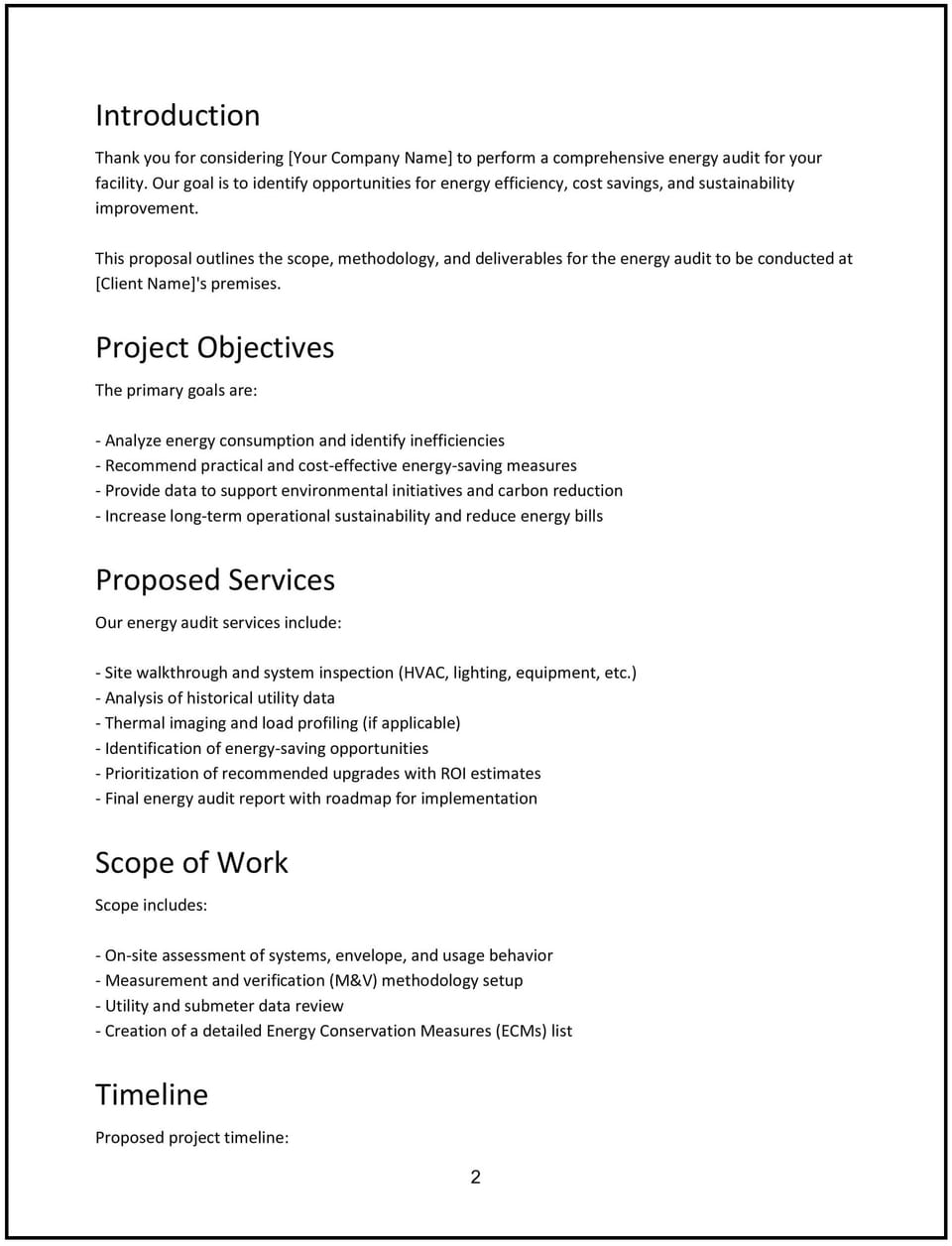Energy audit proposal: Free template

Customize this free energy audit proposal with Cobrief
Open this free energy audit proposal in Cobrief and start editing it instantly using AI. You can adjust the tone, structure, and content based on the building type, energy systems, and client goals. You can also use AI to review your draft — spot gaps, tighten language, and improve clarity before sending.
Once you're done, send, download, or save the proposal in one click — no formatting or setup required.
This template is fully customizable and built for real-world use — ideal for pitching energy efficiency audits for commercial buildings, retail stores, warehouses, or multi-tenant spaces. Whether you're performing basic walkthroughs or advanced assessments, this version gives you a structured head start and removes the guesswork.
What is an energy audit proposal?
An energy audit proposal outlines your plan to assess how a building or facility uses energy and where improvements can be made. It typically includes a summary of the client’s concerns, audit scope, testing methods, reporting outputs, and pricing.
This type of proposal is commonly used:
- In response to high utility bills, sustainability targets, or compliance needs
- As part of broader facility management, retrofit, or ESG initiatives
- After an initial inquiry or site visit to identify potential inefficiencies
The goal is to help the client make informed decisions about energy use, system upgrades, and cost-saving opportunities.
A well-structured proposal helps you:
- Show the value of the audit in simple, business-focused terms
- Clarify what’s included and how the audit will be conducted
- Set expectations around reporting format, timing, and recommendations
- Build trust by showing a structured, credible process
Why use Cobrief to edit your proposal
Cobrief helps you edit and finalize this proposal faster — with built-in AI support and no formatting distractions.
- Edit the proposal directly in your browser: Start editing right away with no downloads or formatting setup.
- Rewrite sections with AI: Tailor the proposal to the client’s facility type, priorities, or decision-maker preferences.
- Run a one-click AI review: Spot weak phrasing, unclear steps, or missing data references.
- Apply AI suggestions instantly: Accept edits line-by-line or apply all improvements with one click.
- Share or export instantly: Send your proposal directly or download a clean PDF or DOCX version in seconds.
You’ll save time and deliver a clearer, more confident pitch.
When to use this proposal
Use this energy audit proposal when:
- Quoting a one-time assessment of a building’s energy usage and efficiency
- Responding to a client concerned about rising utility costs or HVAC performance
- Scoping an energy study ahead of a retrofit, solar install, or lighting upgrade
- Supporting sustainability, LEED, or ESG certification efforts
- Pitching a recurring audit or ongoing monitoring engagement
It’s especially useful when the client is aware of the problem but unsure where to start — and needs structure and clarity from you.
What to include in an energy audit proposal
This template walks clients through the entire audit process — from discovery to delivery — in plain-smart, business-first language.
- Project overview: Summarize the client's current energy concerns and explain how your audit will identify savings or performance opportunities.
- Objectives and metrics: Define success — such as identifying inefficiencies, quantifying savings potential, or benchmarking usage.
- Scope of work: Outline what’s included — equipment inspection, utility bill analysis, thermal imaging, system performance checks, or occupant surveys.
- Methodology: Explain how the audit will be conducted, what tools will be used, and whether it’s a Level 1, 2, or 3 audit (if applicable).
- Reporting and recommendations: Describe what the client will receive — e.g., detailed findings, improvement options, ROI estimates, or a prioritized action plan.
- Timeline and milestones: Break the project into phases — site assessment, data collection, reporting — with estimated durations.
- Pricing: Present your fee structure clearly — fixed, per building, or hourly. Highlight what’s included and call out optional services.
- Next steps: End with a clear call to action — such as scheduling a site walkthrough, confirming scope, or approving the engagement.
How to write an effective energy audit proposal
This proposal should feel accessible, professional, and grounded in practical outcomes — not just technical jargon.
- Speak to both costs and impact: Show how efficiency translates into long-term savings, sustainability, or compliance.
- Keep technical language simple: Avoid acronyms or engineering terms unless you know the audience is technical.
- Focus on what the client gets: Frame the report and recommendations as tools for better decisions, not just diagnostics.
- Make your process feel concrete: Use plain descriptions of how the audit works — clients care more about outcomes than methodology.
- Be upfront about limitations: If certain upgrades aren’t covered or data may be incomplete, say so clearly.
- Close with confidence: End with one simple next step and a timeline for action.
Frequently asked questions (FAQs)
Can I reuse this proposal for different building types?
Yes — this template can be adapted for retail, commercial, industrial, or residential buildings. Just adjust the scope accordingly.
Does this proposal include implementation work?
No — it’s focused on the audit. You can offer implementation services as a follow-up or in a separate proposal.
Can I offer different audit levels?
Yes — you can scope this as a Level 1 (walkthrough), Level 2 (detailed survey), or Level 3 (investment-grade audit), depending on the client’s needs.
Will this proposal help with ESG or LEED reporting?
It can. You can note in the proposal how your audit supports those goals or include a reporting add-on.
Is this proposal a contract?
No — this is a scope and pricing proposal. You can link or attach a formal agreement separately.
This article contains general legal information and does not contain legal advice. Cobrief is not a law firm or a substitute for an attorney or law firm. The law is complex and changes often. For legal advice, please ask a lawyer.